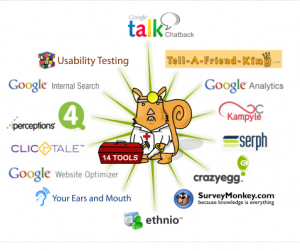As of today, we have spun off ethnio into a separate company! You can read all about it, appropriately, on the new ethnio blog. It’s been five years since we created ethnio, and it’s finally grown enough to leave the warm embrace of our consulting firm, and this will improve things for our customers and help with a whole slew of changes we’re working on.
Category: Live Recruiting
Most user researchers feel they get the best results if they recruit and schedule study participants themselves. We agree. There’s an art to it, which makes it hard to outsource, but it takes a lot of time. An awful lot. Take a minute and think about how many hours you or the people you work with on user research spent on recruiting and scheduling last year. And if you’re conducting guerilla-style research with friends and family or any kind of participants, then we love what you’re doing, but this is for the projects that have more specific criteria and typically require an agency or detailed recruiting effort.
If you’re doing that, please click through for more discussion and a poll.
USER RESEARCH FRIDAY is upon us!
- Date: Friday, Nov. 7th, 2008
- Time: 1pm – 5pm. Drinks and schmoozing 5pm – 7pm.
- Place: Mighty Gallery and Bar at 119 Utah Street. Google Map
- Questions: info@boltpeters.com
- Cost: $50. Register now (space very limited). Students free.
- By: Bolt | Peters User Experience
MORE INFO!
REGISTER NOW!
The Lineup

Indi Young – Author, “Mental Models: Aligning User Strategy with Business”

Steve Portigal – Portigal Consulting
Talk: “Research and Design: Ships in the Night?”

Dan Saffer – Author, “Designing the User Experience”
Talk: “How to Lie with Design Research”
Talk: “Fake Ethnography vs. Real Ethnography”

Dr. Kris Mihalic
Sr Research Manager, Yahoo! Mobile
Talk: “What Mobile Research Accomplishes in 15 Minutes”
Ethnio gets shouted out
The fine folks at Conversion Rate Experts have just posted a blog entry about web tools that help you learn why users abandon your site, and both B|P and Ethnio get shout-outs:
Ideally you want to interview your visitors who aren’t customers yet. That’s where Ethnio comes to the rescue…
Ethnio provides an easy way of adding a pop-up survey to your website, which asks your visitors if they’d like to participate in a usability test. You can customize the survey, so you can ask them details about themselves, such as why they visited your site and whether this is their first visit.
This is all about the pragmatic side of remote research: naturally, getting to know your users is critical for understanding why they’re leaving your site. Using a tool like Ethnio helps ensure that the people you’re talking to actually represent your users. Need a refresher course on live recruiting? I got your Ethnio right here, hombre.
When Live Really Means Live
A couple weeks ago, we were doing research onsite at a client’s office. We had an audience of about 10 and we were live recruiting. It was a high traffic site and we were catching most users within 5 minutes. The interviews were good, but since the focus was on form filling and error message handling, we decided nothing could replace seeing users encounter the pages for the very first time.
So for the last few, we decided to go really, really live. We wouldn’t call a user more than 30 seconds after they filled out the screener, and instead of scrolling back up the list, we’d sit and wait for a qualified user to come in, each time.
We felt a little funny sitting there not doing anything for minutes at a time…and we found out a lot about our clients’ weekends, kids, and hobbies as we all sat watching the response screen, ready to pounce (actually, that was fun). But the quality of the truly live intercept interviews was unparalleled. Users stumbled, reacted to minor issues, and hardly ever said “I would think this” or “I would do that.” Because they were really doing it, right then.
A great reminder about why we do things this way, and how it’s worth it to wait to catch someone “really” live.

Of course by now everyone knows what we mean by “Live Recruits†– they’re usability recruits that we snag when they’re in the midst of visiting the website we’re testing. It’s most often done through mini-surveys on a DHTML overlay (not a popup!). If someone fills out our survey and they’re a match for our target quotas, they’re contacted and interviewed immediately. There’s no scheduling participants and no lag time between the time when a participant is on a site and when they’re interviewed. We talk to them about the tasks they were already doing: no make believe required. It’s the closest way we’ve figured out to observing users interact with a design in their real life circumstances, without artificial barriers of the lab.
This is Not a Dress Rehearsal
In this business we like to say that the person with the freshest eyes has a perspective that is the least tainted. So as the new kid at Bolt | Peters, I thought I’d talk about my take on this whole remote usability thing.
When I first talked to Cyd about how B|P recruits participants in real time, while they’re in the midst of the task we’re actually looking to test, it was a total eureka moment for me. I realized that live recruiting was a brilliant answer to a pain point I hardly realized I had as a usability moderator.
The way it works is, we throw up a DHTML overlay inviting users to participate directly from the website we’re testing. If we’re testing just a single page or sub-section of a site, we recruit from there. Without moving away from what they’re doing, users answer a little questionnaire, which we use to pre-qualify them. We only call users who meet the recruiting requirements. If we’re fast, we can have users on the phone for the study within minutes of filling out the questionnaire. It’s the ultimate in low maintenance recruiting!
Not only is there no pre-session phone interview, no phone tag, no scheduling users, no emailing out confirmations to remind them to show up where and when they said they would. But you actually get real users, who have experience with the site you’re dealing with. They don’t have to fake it.
I can’t tell you how many marginally-qualified people I’ve moderated in the past and what a drag it can be. In the past, whenever I’ve recruited users to bring them into a lab, I would spend the first part of every session getting the user “in the zone.†“Have you ever posted pictures on the Internet? No? Well, could you imagine a situation where you might want to post pictures some day??†It was like being an acting coach, trying to warm up the user and get them into their role. “Imagine you’re an IT manager and you actually do care about purchasing enterprise software.â€
A lot of the users I tested were a little too good at getting into role. Since most of the recruiting was done using Craigslist ads, I’m afraid I had some professional participants on my hands. There seems to be an entire population that’s earning a livelihood from the ETC section of Craigslist. Their unique skill is in working the focus group and usability testing system; the higher the incentive offered, the more they would be able to elaborate on their “qualifications.â€
Of course there is something to be said for the adage that any average Joe should be able to navigate your site. And testing with a Craigslist professional is better than no testing at all. But it’s a very different game when you test with real users. Especially when you catch them very close to the task you’re most interested in learning about. People are relaxed and at ease, and their behaviors are an open book. They don’t need to rehearse; they just need to be themselves.
When we call them up, users often seem pleasantly surprised at actually “winning†something off one of those pop-up boxes (We do offer 75 Amazon bucks for participating). It’s like they’re the subject of a reality TV spot for the duration of the interview. Since they’re in their own space, users sometimes try to multi-task while they’re on the line with us. We see this as a definite plus. We’re peeping into the messiness of their everyday lives and unpredictable online habits. This gives us insights into their actual experience that we just couldn’t get any other way.
One question I did have at the beginning was about whether people would really drop everything, in the middle of their work day to do a 45-minute usability session? What I learned after just a few sessions is that the answer is almost always: “For 75 bucks? You betcha.†That much hasn’t changed. “Lemme just close my office door here, and I’d be glad to talk with you…â€


